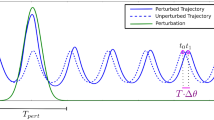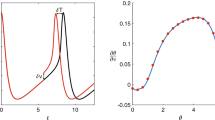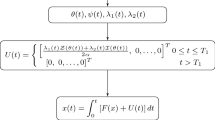Abstract
Many biological oscillators are stable against noise and perturbation (e.g. circadian rhythms, biochemical oscillators, pacemaker neurons, bursting neurons and neural networks with periodic outputs). The experiment of phase shifts resulting from discrete perturbation of stable biological rhythms was developed by Perkel and coworkers (Perkel et al., 1964). By these methods, they could get important insights into the entrainment behaviors of biological rhythms. Phase response curves, which are measured in these experiments, can be classified into two types. The one is the curve with one mapping degree (Type 1), and the other is that with zero mapping degree (Type 0) (Winfree, 1970). We define the phase response curve mathematically, and explain the difference between these two types by the homotopy theory. Moreover, we prove that, if a Type 0 curve is obtained at a certain magnitude of perturbation, there exists at least one lower magnitude for which the phase response curve cannot be measured. Some applications of these theoretical results are presented.
Similar content being viewed by others
References
Guckenheimer, J.: Isochrons and phaseless sets. J. Math. Biol 1, 259–273 (1975)
Harth, E., Lewis, N.S., Csermely, T.J.: The escape of Tritonia: dynamics of a neuromuscular control mechanism. J. Theor. Biol. 55, 201–228 (1975)
Perkel, D.H., Schulman, J.H., Bullock, T.H., Moore, G.P., Segundo, J.P.: Pacemaker neurons: effects of regularly spaced synaptic input. Science 145, 61–63 (1964)
Pinsker, H.M.: Aplysia bursting neurons as endogeneous oscillators. I. Phase-response curves for pulsed inhibitory synaptic input. J. Neurophysiol. 40, 527–543 (1977)
Stein, P.S.G.: Neural control of interappendage phase during locomotion. Amer. Zool. 14, 1003–1016 (1974)
Wilson, D.M.: The central nervous control of flight in a locust. J. Exp. Biol. 38, 471–490 (1961)
Winfree, A.T.: Integrated view of resetting a circadian clock. J. Theor. Biol. 28, 327–374 (1970)
Winfree, A.T.: The investigation of oscillatory processes by perturbation experiments. In: Biological and biochemical oscillators. pp. 461–501. Chance B., Pye, E., Gosh, A., Hess, B., eds. New York: Academic Press 1973
Winfree, A.T.: Resetting biological clocks. Physics Today 28, 34–39 (1975)
Winfree, A.T.: Phase control of neural pacemakers. Science 197, 761–763 (1977a)
Winfree, A.T.: Some principles and paradoxes about the phase control of biological oscillators. J. Interdiscip. Cycle Res 8, 1–14 (1977b)
Yamanishi, J., Kawato, M., Suzuki, R.: Investigations of human finger tapping neural networks by PRC. The 17-th congress of Japan society of medical electronics and biological engineering 1978 (in Japanese)
Author information
Authors and Affiliations
Rights and permissions
About this article
Cite this article
Kawato, M., Suzuki, R. Biological oscillators can be stopped—Topological study of a phase response curve. Biol. Cybernetics 30, 241–248 (1978). https://doi.org/10.1007/BF00361045
Received:
Issue Date:
DOI: https://doi.org/10.1007/BF00361045




